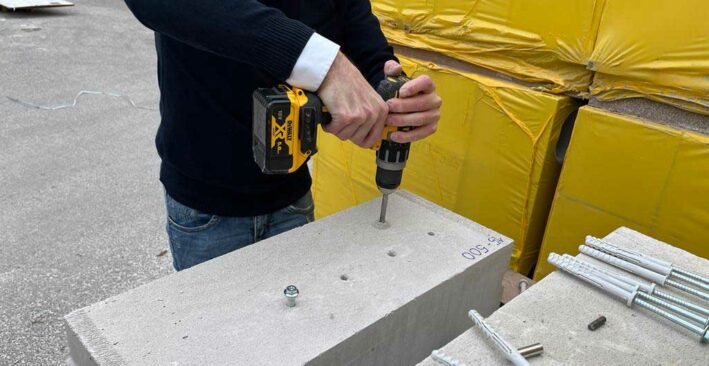Drilling in concrete is difficult because concrete is dense, and has embedded aggregates that can get in the way of the drill bit – Drilling can quickly ruin drill bits. When the drill bit encounters an aggregate, it drags further. One of the most commonly used tools for drilling through concrete is a hammer drill.
A hammer drill has the function of a hammer, which consists of the drill bit not only rotating on itself but also making a small movement back and forth to break the material and facilitate drilling. In the case of concrete, the hammering helps to pulverize the concrete, while the rotation forms the hole.
On the other hand, it is also possible to drill concrete with a rotary drill, these take longer to drill the concrete compared to a hammer drill and require greater physical effort, in addition, the excess heat generated in the drill can break the drill bit.
Steps to drill into concrete
- 1: Mark the position of the holes
While it might not always be necessary it is recommend that you mark where you will need to drill for your fixings, especially if you need to drill multiple holes to balance the loads.
- 2: Know how to drill the hole
Get your drill ready by setting the depth control bar if you have one or mark on the drill where you should drill up to. This will depend on the length of the screw or anchor you are trying to fix and the thickness of the application you are installing.
- 3: Drill the hole
Start by slowly drilling your hole to make sure you have control when first drilling in to concrete. Once you have an established hole you will be able to drill faster.
- 4: Clean out the hole
Once you have drilled the hole it is important to make sure you clear it of any dust. Removing any dust will improve the strength and holding of the anchors. You could use an air pump, can of compressed air, or vacuum.
- 5: Fix your concrete anchor!
Concrete screws
To install a screw into concrete all you have to do is drill a hole in the concrete, clean out the hole and drive in the screw, no hammering required! Concrete screws are an excellent option when looking to fasten close to an edge, as there is no expansion and pressure on the base material is reduced.
Although the installation process may seem easy, you have to make sure you follow the correct installation process according to the ETA. This includes things like cleaning out the drill hole, using the correct amount of torque and not overtightening the screws.
Concrete screws come with different types of heads, including pan or hex head as well as connecting or internal thread heads. Your choice of screw will depend on the application and location of the installation.
How to use a concrete screw
To install a screw into concrete all you have to do is drill a hole in the concrete and drive the screw. Concrete screws are an excellent option when looking to fasten close to an edge, as there is no expansion and pressure on the base material is reduced.
Concrete screws come with two types of heads: Hex Head and Flat Head Screws. Hex screws are easier to fit but don’t look as good because the head is raised and doesn’t sit flush with the surface, so your choice depends on the location of the screw.
Concrete fasteners
If you are wondering what concrete fasteners exist, here we will list some of the other most popular options on the market: sleeve anchors, chemical anchors, frame fixings and the concrete screws, each of them has different characteristics and the choice will depend on what you need.
Sleeve anchors are used to connect structural and non-structural elements to concrete, it is an excellent solution for installations on the wall due to its thicker width providing a higher shear resistance
Chemical anchors provide a more flexible option to mechanical anchors for heavy duty fixings. They can be used close to the edge and have shorter spacing distances because they do not exert stress on the base material. They can also be used with many different base materials other than concrete.
Frame fixings such as the Multifunction frame plug MFR, are ETA approved for fixing in concrete. The long expansion area and early expansion achieved by the lateral bars ensure a secure hold, also providing them with high load values.
Finally, as we have mentioned before, the concrete screw allows faster installations, since the number of steps necessary for installation is reduced. It also provides flexibility, since if you need to, you can remove the screw once it has been installed. This is perfect for those times when a project changes or a mistake is made, and the fastener placement needs to be readjusted.


